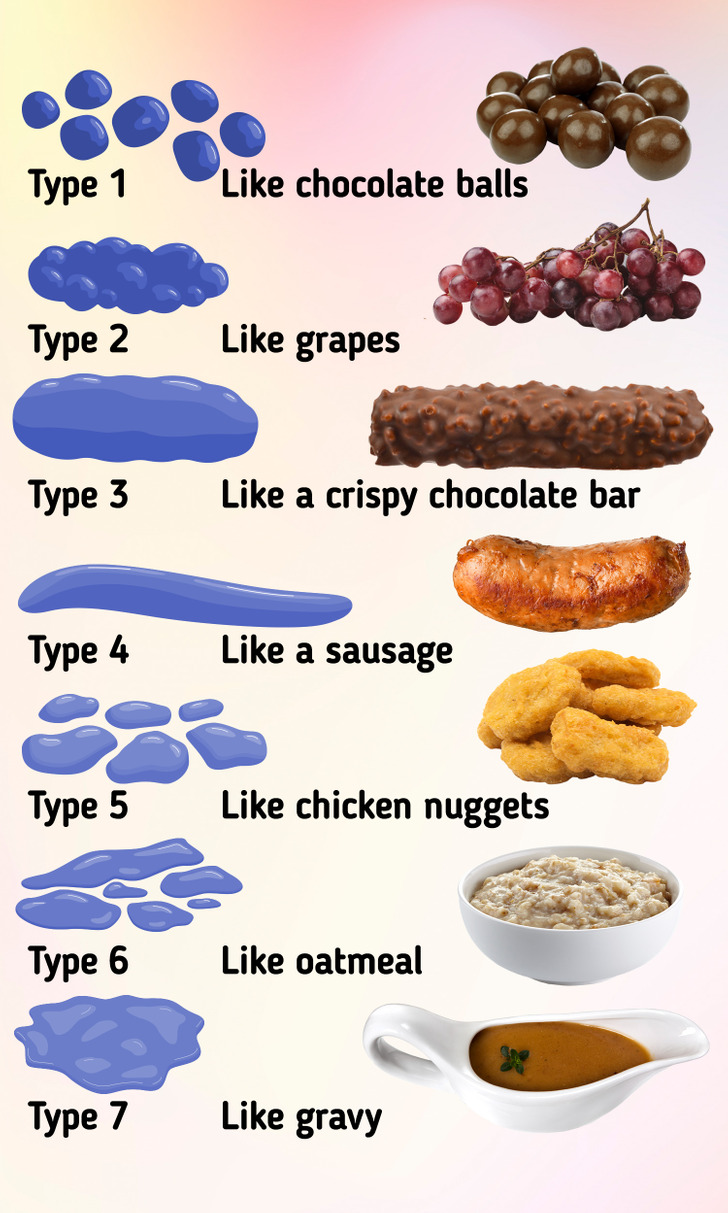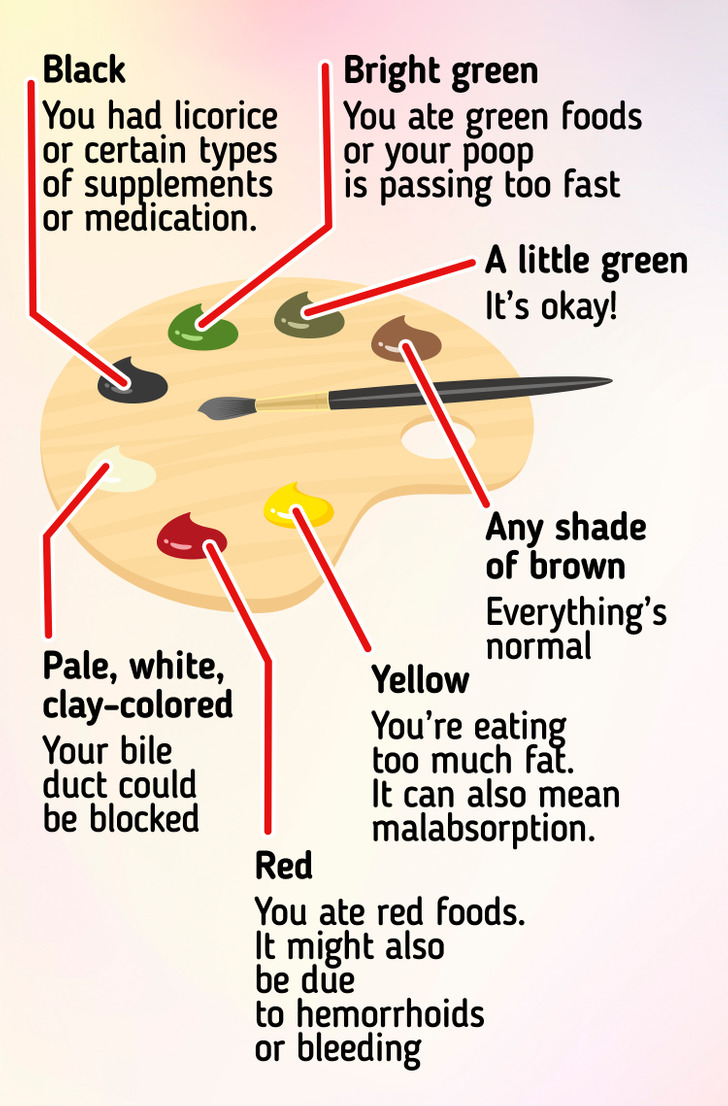What the Appearance of Your Poop May Say About Your Health
There’s no doubt that every person is unique, and this includes the way they poop. However, certain aspects of this digestive process may indicate whether your stool is in the ideal condition every time you visit the bathroom to go number 2.
5-Minute Crafts will help you spot what the appearance of your poop may be telling you about your health.
❗Important: This article has been created for informative purposes only and does not replace professional advice. Consult your doctor for a proper diagnosis and treatment if any irregularities in your poop last for more than a day or 2.
A. Shape and consistency
Since it can be difficult to describe your poop’s appearance, doctors use the Bristol stool chart. This can help you determine how long your feces have been in your intestines before having a bowel movement.
- Type 1: The stool looks like isolated hard lumps, similar to nuts or chocolate balls. These are hard to pass as they’ve been in your intestines for a long time. If your poop looks like this, you’re likely to be constipated. If you see that it has the same appearance for more than a couple of weeks, consult your doctor to find out what may be causing it.
- Type 2: The poop seems like a lumpy sausage or grapes. This appearance can also be a sign of constipation. If this is your case, it’s advisable to add more fiber to your meals and drink plenty of water.
- Type 3: The stool has the shape of a sausage with cracks on it, like a crispy chocolate bar. This is considered normal as it has a soft texture and is not difficult to pass. If everything is working as expected, it shouldn’t take more than a minute to have a bowel movement.
- Type 4: The poop looks like a smooth, soft sausage. Doctors consider this type the ideal one. Although everyone has different toilet habits, you should pass a stool like this every 1-3 days.
- Type 5: The stool seems like soft blobs with well-defined edges, similar to chicken nuggets. Although they’re easy to pass, you may experience a sense of urgency when heading to the bathroom, which can indicate mild diarrhea. This symptom usually goes away after a couple of days.
- Type 6: The poop looks like mushy pieces with irregular edges, similar to oatmeal. If your stool looks like this more than 3 times per day, it’s considered diarrhea. Drink plenty of liquids, but not just water, as your body needs to replace all the minerals you’re losing. Soup and fruit juices can be helpful.
- Type 7: The stool is liquid and has no solid pieces, like gravy. This type of poop passes through the intestines very fast. Consult your doctor if your poop looks like this more than 3 times a day for over 2 days.
As you may notice in the scale above, types 1 and 2 indicate constipation, whereas types 3, 4, and 5 are usually considered within the normal stool form. On the other hand, types 6 and 7 are signs of diarrhea.
B. Color
Besides the aspects mentioned before, your poop’s color can also help you identify what may be happening in your body. While any shades of brown, and even a little green, are considered normal, you may want to know what other colors could be telling you.
- Black: This color can appear after you’ve consumed licorice, bismuth medications, or iron supplements. However, if you haven’t had any of these, black stool might be a sign of bleeding in the upper part of the gastrointestinal tract.
- Green: While poop with a little green is normal, full green poop may indicate a couple of things: either you’ve eaten a lot of green food, or your poop is passing through your body too quickly. When your stool doesn’t grab as much bilirubin, it contains more bile salts that make it look like this.
- White, pale, or clay: If your stool has a chalky light appearance, it could mean that there’s a bile deficiency. Bile flows from your gallbladder and liver. Therefore, if your poop looks white, your bile duct could be blocked. At the same time, pale poop can also indicate that you’ve consumed certain types of medication, such as anti-diarrhea medicine. Regardless of the reason, see a doctor if this symptom doesn’t go away.
- Red: You’ve likely heard that red poop can be a sign of bleeding as a cause of hemorrhoids or issues in the lower digestive tract. However, if your poop has hints of red, you may not need to worry. Certain foods like red gelatin, tomato juice, cranberries, and beets can cause this color.
- Yellow: Greasy, foul-smelling yellow poop usually indicates that you’ve been consuming too much fat. It can also be a sign of celiac disease, which means that your body is not absorbing the proper amount of nutrients. If your stool seems bright yellow, it might mean you have giardiasis, a medical condition caused by an intestinal parasite.
C. Other aspects
Even though your poop’s shape, consistency, and color can say a lot about your health, you may wonder what other aspects could mean. One of these includes whether your poop floats when it enters the toilet bowl. Floating stool indicates that it’s less dense than poop that sinks into the water, which may be caused by a high amount of water or gas, or a diet rich in fiber. Malabsorption is another possible reason for floating poop, which might come along with slight constipation.
At the same time, your poop’s smell can also be a sign of certain conditions. While it’s completely normal that feces aren’t pleasant to the nose, foul-smelling poop with a strong odor can be the result of foods you may have eaten or the bacteria in your colon. Some more serious causes of bad-smelling poop include celiac disease, food allergies, dairy protein intolerance, and infections.


